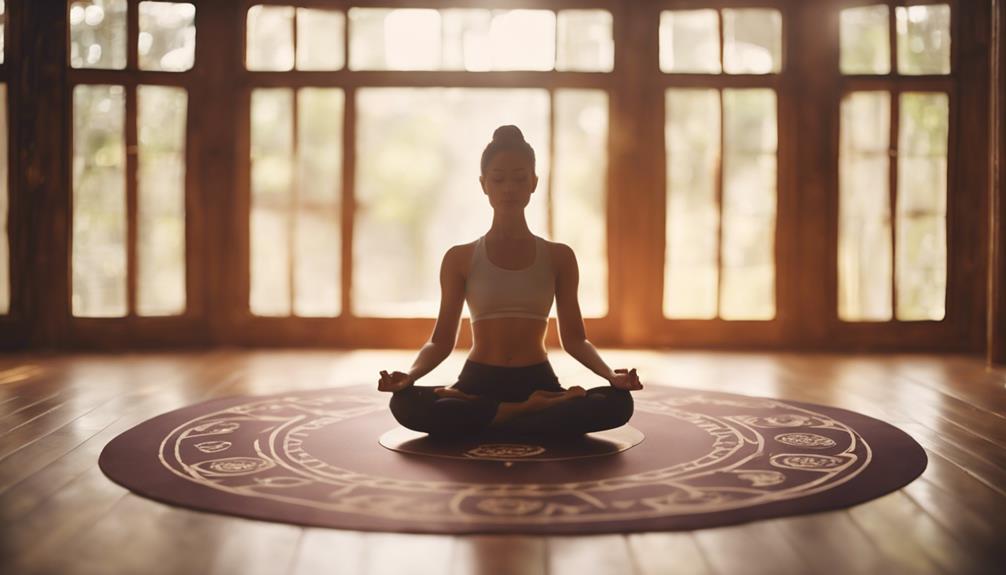Practicing yoga outdoors can transform your routine, allowing you to connect with nature while engaging in mindful movement and breath. The changing scenery and fresh air can elevate your practice, making it more enjoyable and refreshing. Creating an outdoor yoga space not only fosters a deeper connection to the environment but also provides a serene and inviting refuge for physical and mental well-being. In this article, we will explore various ideas and considerations for establishing a beautiful outdoor yoga space that complements your practice.
1. Benefits of Practicing Yoga Outdoors for Mind and Body
Practicing yoga outdoors offers numerous benefits for both the mind and body. One of the most significant advantages is the positive impact of nature on mental health. Being in a natural setting can reduce stress, enhance mood, and increase feelings of well-being. The sights, sounds, and smells of the outdoors create a calming ambiance that often leads to a deeper meditative state, allowing practitioners to connect more profoundly with their breath and movements.Yoga Nosara
Physically, outdoor yoga can diversify your practice by introducing natural elements such as uneven surfaces or varying temperatures. This variation can improve balance and stability, making your body more adaptable. The exposure to natural sunlight also aids in vitamin D synthesis, which is essential for overall health. As you breathe in the fresh air and soak in the surrounding beauty, you may find your practice becoming more invigorating and energizing.
2. Choosing the Right Location for Your Outdoor Yoga Space
Selecting the perfect location for your outdoor yoga space is crucial to creating an inviting and effective environment. Look for a spot that offers a balance of tranquility and accessibility. Ideally, your chosen location should be away from noisy streets and distractions, allowing you to immerse yourself fully in your practice. Parks, gardens, or your own backyard can serve as excellent options as they often provide the necessary peace and quiet.
Consider the scenery and natural light in your selected area. A location with beautiful views, whether of trees, mountains, or water, can enhance your experience and inspire mindfulness. Additionally, think about the surfaces available – grassy areas are often preferable due to their softness and comfort. However, ensure that the ground is level and safe to prevent any potential injuries during your practice.
3. Essential Elements for a Comfortable Yoga Environment
To create a comfortable outdoor yoga environment, several essential elements should be considered. First and foremost, investing in a quality yoga mat designed for outdoor use can significantly improve your experience. Look for mats with extra grip to prevent slipping on grass or other surfaces. Additionally, consider using a mat with extra cushioning to provide support, especially on harder ground.
Creating a shaded area can also contribute to comfort while practicing outdoors. Whether through natural shade from trees or the addition of a portable outdoor umbrella, protection from direct sunlight can prevent overheating and ensure a more pleasant experience. Lastly, having a designated space for your belongings, such as a small table or storage basket, can keep your area organized and free of distractions during your practice.
4. Natural Features to Incorporate into Your Yoga Area
Incorporating natural features into your outdoor yoga space can enhance the ambiance and promote a deeper connection with nature. Elements such as rocks, plants, and water can create a serene environment that complements your practice. For example, placing smooth stones or pebbles around your yoga area can serve as decorative elements while reminding you of the natural world.
Additionally, if your location allows, consider adding a small water feature like a fountain or pond. The sound of flowing water can be soothing and help mask any external noise, creating a tranquil atmosphere conducive to meditation and focus. Surrounding your space with lush greenery or flowering plants can also add beauty and inspiration, making it a more inviting sanctuary for your practice.
5. Creative Seating Options for Your Outdoor Yoga Setup
While yoga can primarily be practiced on mats, incorporating creative seating options can enhance comfort and versatility in your outdoor space. Consider adding cushions, bean bags, or even hammocks for relaxation and stretching during your sessions. These seating choices can provide a comfortable way to transition between poses or take breaks in between practices.
Additionally, using natural materials for seating can enhance the aesthetic appeal of your outdoor yoga area. Wooden benches or logs not only provide stability but also blend seamlessly with the surrounding environment. This approach not only fosters a rustic charm but also encourages a strong connection with nature, making your yoga space feel more integrated into the outdoors.
6. How to Choose the Best Time of Day for Yoga Outdoors
Choosing the right time of day for outdoor yoga is essential for maximizing comfort and enjoyment. Early morning is often considered the best time as the air is typically cooler, and the world is quieter. Practicing at dawn allows you to witness the beauty of the sunrise while benefiting from the tranquil energy of the morning. The gentle light can also aid in grounding your practice, making it an ideal time for meditation.
Alternatively, evening sessions can offer a unique and soothing experience as the sun sets. The cooler temperatures and the setting sun create a calming atmosphere, allowing for reflection and relaxation. However, consider local wildlife and insects; if practicing during the evening, be mindful of mosquitoes and other pests. Regardless of the time you choose, aim for moments when you feel most at peace with your surroundings.
7. DIY Ideas for Creating an Inviting Yoga Sanctuary
Creating an inviting yoga sanctuary outdoors can be accomplished with a few DIY projects that reflect your personality and style. For example, you can make a simple outdoor altar using natural materials like stones, driftwood, or plants. This altar can hold items that promote mindfulness, such as crystals, candles, or meaningful symbols that resonate with your practice.
Another idea is to create a pathway leading to your yoga space using stones or mulch. This not only enhances the aesthetic appeal but also sets a clear intention for your practice, signaling a transition from the outside world to your personal sanctuary. Incorporating handmade decorations like wind chimes or hanging lanterns can further enhance the space, adding a touch of whimsy and tranquility.
8. Incorporating Nature Sounds to Enhance Your Practice
Incorporating nature sounds into your outdoor yoga practice can greatly enhance your experience by promoting relaxation and focus. The gentle rustle of leaves, the chirping of birds, and the distant sound of water can create a natural soundtrack that complements your movements. To make the most of these sounds, select a location where such natural noises can be easily heard and appreciated.
If your surroundings are relatively quiet, consider using a portable speaker to play calming nature sounds or soft music that aligns with your practice. Creating a playlist filled with sounds of rain, ocean waves, or gentle wind can help set the mood. This auditory element can support your mindfulness and allow you to cultivate a deeper connection with your environment.
9. Tips for Keeping Your Outdoor Yoga Space Organized
Maintaining an organized outdoor yoga space is essential for a smooth and enjoyable practice. Start by creating designated storage solutions for your yoga mats, props, and any additional equipment. Consider using a stylish basket or outdoor shelves to keep everything neatly stored and easily accessible. This not only prevents clutter but also creates a visually appealing environment.
Regularly cleaning your space is also important to ensure that it remains inviting. Clear away any debris, such as leaves or dirt, before each practice to create a clean area. Additionally, periodically assess your organization system to make sure it meets your needs. A tidy and well-organized space can significantly enhance your outdoor yoga experience and encourage consistent practice.
10. Considerations for Weather and Seasonal Changes in Yoga
When planning your outdoor yoga space, it’s essential to consider the weather and seasonal changes. Since outdoor conditions can vary greatly, having a flexible approach can help you adapt your practice. For instance, investing in a portable canopy or tent allows you to create shade during hot summer months or shelter from light rain. This flexibility ensures that you can practice comfortably regardless of the weather.
Additionally, be mindful of seasonal changes as you develop your outdoor space. As the seasons shift, the surrounding environment may change dramatically. In fall, the colors of the leaves can create a picturesque backdrop, while winter may require additional layers for warmth. Adapt your practice and space according to the season, whether it includes extra blankets for colder months or refreshing the decor to reflect seasonal changes.
Creating an outdoor yoga space can significantly enhance your practice by merging the benefits of yoga with the tranquility of nature. By carefully selecting your location, incorporating natural elements, and maintaining an organized environment, you can create a serene sanctuary that fosters mindfulness and comfort. As you explore different ideas and personalize your space, remember to embrace the ever-changing beauty of the outdoors, allowing it to inspire and elevate your yoga journey. Whether you’re practicing alone or inviting friends, your outdoor yoga oasis can become a cherished part of your routine.


